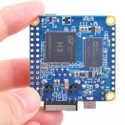Automation controller runs Linux on a NanoPi Neo SBC
Nov 13, 2017 — by Eric Brown 2,948 views Techbase launched a “ModBerry M300” automation controller built on a NanoPi Neo, and added M-Bus and M-Bus Wireless support to its ESP32-based Moduino.
Techbase launched a “ModBerry M300” automation controller built on a NanoPi Neo, and added M-Bus and M-Bus Wireless support to its ESP32-based Moduino.
Gdansk, Poland based Techbase has added another member to its Linux-driven ModBerry family of automation controllers. The latest ModBerry is built around FriendlyElec’s open source NanoPi Neo SBC. The company has also updated its ESP32-based Moduino device to run mBus10/60/400 converter modules for M-Bus support, as well as M-Bus Wireless modules.

ModBerry M300
(click image to enlarge)
ModBerry M300
— ADVERTISEMENT —
The ModBerry M300 offers automation controller functions that are much like earlier ModBerry models, including the three models announced in July. These include the ModBerry 500 (M500), which was revised to run on the Raspberry Pi Compute Module 3, an M700 model built around FriendlyElec’s NanoPi M1 Plus, and an M1000 built on an UP board with a “Cherry Trail” Intel Atom x5-Z8350 SoC.
 NanoPi Neo |
Thanks to the compact 40 x 40mm size of the NanoPi Neo SBC, Techbase was able to shrink the system to 91 x 71 x 61mm compared to 106 x 91 x 61mm for the other ModBerry systems. Like the NanoPi M1 Plus SBC on the M700, the M300’s NanoPi Neo adopts the 1.2GHz, quad-core, Cortex-A7 Allwinner H3 SoC. The M300 supports Linux 4.11.2+ with U-Boot in flavors including Debian, Ubuntu Core, and Android.
Like the other ModBerry models, the M300 is designed to work with Modbus RTU and TCP/MQTT/SNMP networks. You can “seamlessly” add Modbus serial slave devices to an existing Modbus TCP network, and make Modbus TCP slaves accessible to serial masters. A remote web access panel enables group management.
All the Modberry computers are supported with the company’s cloud-based iMod, iModCloud, and iModWizard Software-as-a-Service (SaaS) applications. The ModBerry devices can be set up as protocol converters, data loggers, telemetry modules, servers, PLC devices, ModBus routers, SNMP agents, and M-Bus devices.
Like its forebears, the M300 automation controller offers DIN rail mounting, wide-range (9-30V DC) input, and 0 to 60°C and optional -40 to 70°C support. Power consumption is claimed to be 20W, or 40W when equipped with an optional modem.
The M300 ships with 512GB DDR3 and a microSD slot, as well as 10/100 Ethernet, USB 2.0 host, RS-232, and RS-485 ports. A second USB header is onboard, along with 2x DIO interfaces, an RTC, and a watchdog. There’s also an mBus Master interface for connecting up to 10x slave devices,
Optional modems include 150Mbps 802.11 b/g/n — unlike the NanoPi M1 Plus, NanoPi Neo Air, and NanoPi Neo Plus2, the Neo has no onboard WiFi. Other wireless options include LTE/3G/GPRS, ZigBee, Bluetooth, LoRa, Wireless M-Bus, NB-IoT (LTE cat. NB1), and GPS, which is also available in combo modules with GPRS and 3G. SigFox support is noted in the announcement, but is not mentioned on the product page.
In addition to the wireless options, there are internal I/O options called ExCard modules, up to three of which can be used simultaneously. ExCards include up to 4x RS232/485, up to 2x Ethernet, up to 12x analog outputs, up to 8x analog inputs, and 12x DIO. Available ExCards also include PCIe, 4x relay, an accelerometer, and an opto-isolated power supply and I2C serial bus.
In addition to the ExCards, there are also mBus add-ons with interfaces to RS232 or RS485 converters for connecting up to 10x, 60x, or 400x slave devices. A wide range of other accessories include ZigBee sensors and relays, 1-Wire sensors, antennas, power feeders, and more.
Moduino updated with M-Bus and M-Bus Wireless
Techbase has added M-Bus and M-Bus Wireless support to its recently announced Moduino automation controller, which is billed as the world’s first ESP32-based industrial computer. The Moduino is available in Moduino X1 and larger Moduino X2 models, and offers standard WiFi and Bluetooth, and optional LoRa, Sigfox, LTE, Ethernet, and battery power. The device supports ESP-IDF, Zephyr, Arduino, MicroPython, and Mongoose OS development environments.

Moduino X1
(click image to enlarge)
The Moduino can now be equipped with TechBase’s mBus10/60/400 converter module, which operates as a M-Bus Master. You can connect up to 400 standard M-Bus slave receivers or alternatively, fewer devices at a higher M-Bus load over long distances, says Techbase. As a result you can connect to any device equipped with an M-Bus interface, including heat meters, electricity meters, gas meters, executive modules, recorders, and measuring instruments.
Techbase has also added an optional wireless M-Bus module and multi-hop networking to the Moduino product line. The wireless M-Bus module is configured as an “embedded micro system or simple data modem” for low power applications in the metering-specific 169 MHz or the 868 MHz ISM bands. Wireless M-Bus output power can be increased up to +30 dBm on the 169 MHz band and up to +15 dBm on the 868 MHz band.
Finally, the Moduino sensor layer and ModBerry gateway controller layer have been enhanced to “fully work” with new and existing MQTT networks, says Techbase.
Further information
The ModBerry M300 and revised Moduino with M-Bus support appear to be available now with undisclosed pricing. More information may be found at Techbase’s ModBerry and Moduino product pages.

Please comment here...